Plain turnip can be safely canned at home using a pressure canner. There is no water-bath method.
The follow directions are from the USDA.
- 1 The Recipe
- 2 Canning turnip
- 3 Reference information
- 4 Recipe notes
- 5 Source
- 6 Nutrition
- 7 Why is there a question mark hanging over canning turnip
- 8 A tale of two turnips
- 9 What is the pressure canning method for plain turnip?
- 10 Turnip greens
- 11 How to use canned turnip
- 12 Cooking with canning recipes
- 13 Pickling recipes for turnip
The Recipe
Jar size choices: Either half-litre (1 US pint) OR 1 litre (1 US quart)
Processing method: Pressure canning only
Yield: varies
Headspace: 3 cm (1 inch)
Processing pressure: 10 lbs (69 kPa) weighted gauge, 11 lbs (76 kpa) dial gauge (adjust pressure for your altitude when over 300 metres / 1000 feet.)
Processing time: Half-litres (pints) 30 minutes; litres (quarts) 35 minutes.
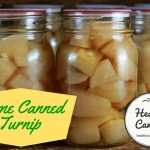
Canning turnip
Instructions
- Wash turnip, then peel.
- Cut into cubes or chunks 3 to 5 cm (1 to 2 inches).
- Blanch the cubes in boiling water for 3 to 5 minutes.
- Pack into jars leaving 3 cm (1 inch) headspace.
- Top up with fresh boiling water leaving 3 cm (1 inch) headspace.
- Season jar with a teaspoon or half-teaspoon of salt or salt sub if desired.
- Wipe jar rims.
- Put lids on.
- Put in pressure canner.
- Processing pressure: 10 lbs (69 kPa) weighted gauge, 11 lbs (76 kpa) dial gauge (adjust pressure for your altitude when over 300 metres / 1000 feet.)
- Processing time: half-litre (1 US pint) jars for 30 minutes. OR 1 litre (1 US quart) jars for 35 minutes.
Nutrition
Processing guidelines below are for weighted-gauge pressure canner. See general table here for dial-gauge altitude adjustments.
| Jar Size | Time | 0 to 300 m (0 - 1000 feet) pressure | Above 300 m (1000 ft) pressure | |
|---|---|---|---|---|
| ½ litre (1 US pint) | 30 mins | 10 lbs | 15 lb | |
| 1 litre (1 US quart) | 35 mins | 10 lbs | 15 lb |
Reference information
How to pressure can.
When pressure canning, you must adjust the pressure for your altitude.
More information about Salt-Free Canning in general.
Recipe notes
- The reason for washing the turnip before peeling is to reduce bacterial level before peeling so that you don’t drive bacteria into the flesh of the turnip while peeling.
- After peeling the turnip, put two pots of water on: one to blanch the turnip in, and one to use for bottling water. You can of course boil the canning water in a kettle, instead.
- So Easy to Preserve says blanch for 5 minutes; Ball says blanch for 3 minutes.
- The salt is optional. It’s just a seasoning here and adds nothing to safety — that comes from the pressure canning. You can omit the salt, or use a non-bitter, non-clouding salt sub. We found Herbamare Sodium-Free performs well in that regard.
Source
Turnips. In: Andress, Elizabeth L. and Judy A. Harrison. So Easy to Preserve. University of Georgia Cooperative Extension. Bulletin 989. Sixth Edition. 2014. Page 96.
Parsnips, Rutabagas, or Turnips. In: Ball Blue Book. Muncie, Indiana: Healthmark LLC / Jarden Home Brands. Edition 37. 2014. Page 114.
Turnips, Parsnips. In: Bernardin Guide to Home Preserving. Toronto, Canada: Bernardin Ltd. 2013. Page 104.
Nutrition
Serving size: 100 g (1 cup, cubes)
Nutritional information based on no added salt.
Per 100 g (1 cup): 28 calories, 67 mg sodium.
Weight Watchers PointsPlus®: 0 points regardless of quantity.
Why is there a question mark hanging over canning turnip
The general advice from all the university extensions is that turnip can be safely pressure canned: however, they add, you’re not gonna like it: “Turnips may be canned but usually discolor and develop strong flavor when canned.” [1] McGarry, MSU Extension Educator. Using, Storing and Preserving Turnips. Michigan State University Extension. Bulletin HNI46. April 2012. Page 1. Accessed March 2015.
The same advice can be seen being applied to turnip’s close cousin, rutabaga, except if anything, the advice is more emphatic when applied to rutabaga.
A tale of two turnips
It’s not as black and white as that, though. Your results will depend upon the variety of turnip that you can.
Some varieties of turnip will discolour and turn from white to an unappealing brown. Others don’t discolour as much.
Some varieties also taste less strong when canned. Some people report canning turnips and are surprised that some other people haven’t liked the taste, as the turnips they canned, they say, tasted great. It’s possible that those people are canning different varieties.
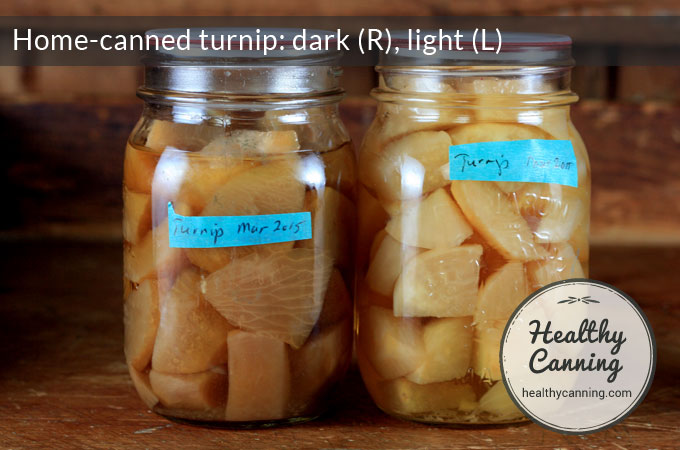
A tale of two turnips: one variety will darken, another will not.
Part of the problem, though, is that when purchasing turnips at a market, consumers won’t have any idea which variety they are purchasing.
The Joy of Cooking team had this to say about the best varieties to can:
Sweet, crisp young turnips remain tasty and firm when canned. Superior canning varieties are Market Express, Purple Top White Globe, Tokyo Cross. Select tender young turnips no more than 3 inches (7.5 cm) wide. Wash thoroughly and peel. Can 1-inch-wide (2 to 3 cm) young turnips whole. Cut larger turnips into 1-inch (2 to 3 cm) cubes.” [2] Irma von Starkloff Rombauer, Marion Rombauer Becker, Ethan Becker. All about Canning and Preserving. Simon and Schuster, 2002. Page 41.
So, in summary, you will hear some people saying turnip cans up awful; other people saying it cans up fine. Provided that both are turnip lovers to start with (some people would still hate it even if you gave it to them candied!), the different experiences being reported may just be down to the varieties they had to work with, without realizing it.
What is the pressure canning method for plain turnip?
All reliable recipe sources require the same processing method and time, though they vary slightly on the preparation.
They all require a hot pack approach.
Here are the University of Michigan extension directions:
Hot pack method: Wash turnips, scrubbing well. Peel, slice or dice. Place turnips in a saucepan, cover with boiling water and boil 5 minutes. Pack hot pieces into hot jars, leaving 1 inch (2 cm) headspace. Add ½ teaspoon salt to pints, 1 teaspoon to quarts, if desired. Fill jar to 1 inch (2 cm) from top with boiling hot cooking liquid. Remove air bubbles. Wipe jar rims. Adjust two-piece lids, tighten and process. Process in a dial-gauge pressure canner at 11 pounds pressure OR in a weighted-gauge pressure canner at 10 pounds pressure. Pints (½ litre) 30 minutes; quarts (1 litre) 35 minutes.” [3] McGarry, MSU Extension Educator. Using, Storing and Preserving Turnips. Michigan State University Extension. Bulletin HNI46. April 2012. Page 1. Accessed March 2015.
Ball and Bernardin agree on the above directions, except they require only a 3 minute blanch. [4] Ball Blue Book. Muncie, Indiana: Healthmark LLC / Jarden Home Brands. Edition 37. 2014. Page 114. [5] Bernardin Guide to Home Preserving. Toronto, Canada: Bernardin Ltd. 2013. Page 104 Ball suggests a 1 inch (2 cm) headspace; Bernardin suggests leaving 1 ¼ inch (3 cm) while packing the turnip in and then topping up with the boiling water to 2 cm (1 inch).
Penn State Extension suggests that the turnip should be cut into cubes 1 cm (½ inch).
So to sum up everyone’s directions:
- cut into cubes or chunks
- blanch 3 to 5 minutes;
- pack into jars leaving 2 to 3 cm (1 to 1.25 inch) headspace;
- top up with fresh boiling water leaving 2 to 3 cm (1 to 1.25 inch) headspace;
- process half-litre (1 US pint) jars for 30 minutes;
- process 1 litre (1 US quart) jars for 35 minutes.
Note: Don’t combine loads of turnip with jars of something else that requires a longer processing time in the pressure canner, or even the varieties of turnip that don’t darken so much will darken on you when over-processed.
Note: Ball and Bernardin both call for turnip as an ingredient in their home-canned vegetable stock, but call for it to be strained out and discarded before the stock is canned.
Turnip greens
You can can turnip tops. The University of Alaska Fairbanks Cooperative Extension Service gives these directions:
Turnip greens: Greens may be canned; however, freezing results in a better product. Leaves should be tender and attractive in color. Wash thoroughly in several changes of water. Cut out tough stems. Blanch 1 pound (500 g) of greens at a time until wilted (3 to 5 minutes). Pack hot greens loosely into hot jars, leaving 1 inch (2 cm) head space. Add 1⁄4 teaspoon salt to pints; 1⁄2 teaspoon to quarts, if desired. Fill jars to 1 inch (2 cm) from top with boiling water. Remove air bubbles. Wipe jar rims. Cover with hot lid and tighten screw bands. Process in a dial gauge pressure canner at 11 pounds pressure or in a weighted gauge pressure canner at 10 pounds pressure: pints (½ litres), 70 minutes; quarts (litres), 90 minutes.” [6] Shallcross, Leslie. Tantalizing Turnips. University of Alaska Fairbanks Cooperative Extension Service. October 2011. Bulletin FNH-00463
How to use canned turnip
Canned turnips could be used in turnip soups, or in baked, creamed turnip recipes. The University of Alaska extension provides several such recipes.
If you have home canned squash and / or home canned carrots to hand, a mixed mash of those drained veg (with some fat-free sour cream or yoghurt, and seasoning), provides a great quick low-cal and filling side dish.
You can freeze the water from your drained canned turnip in tubs to use in soups.
Cooking with canning recipes
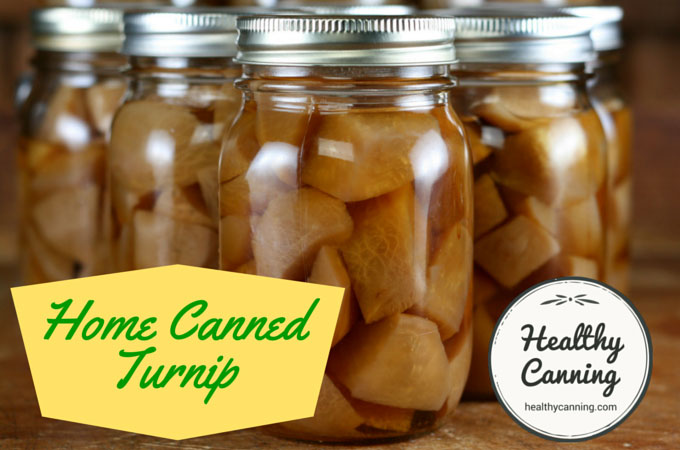
Turnip which came out dark.
Pickling recipes for turnip
Pickled turnip is also know by its German name of “Sauerrüben.”
Turnip and rutabaga can be water-bathed canned (or steam-canned) if they are pickled. There are, however, very few recipes for pickled, canned turnip out there amongst the reputable sources.
The National Center for Home Food Preservation says,
You also had asked us in another message about pickling turnips, and I’m sorry, but we do not have recommendations for canning pickled turnips. We would not assume that they could be pickled and canned the same way as beets, and we do not recommend that you try to do so. There are, however, recommendations for pressure canning turnips from the Cooperative Extension Service that are the same as our recommendation in So Easy To Preserve, here: https://www.uaf.edu/files/ces/publications-db/catalog/hec/FNH-00463.pdf . ” [7] NCHFP Blog Posting. Wintertime Greens. 28 Jan 2014. Accessed July 2015.
Most pickling recipes for turnip are for refrigerator storage, not canning. Note that many of these involve fermentation, so actual salt would be required for safety, salt sub cannot be used in fermentation.
Trusted home canning author Linda Ziedrich in her Joy of Pickling (all three editions) provides a fermented and cannable recipe for Sauerruben (German for “sour turnip.”) Note that this is a fermented pickled turnip, and must be made with salt for safety. [8] Ziedrich, Linda. The Joy of Pickling. Boston, Massachusetts: The Harvard Common Press. 2009. Page 63.
Some recipes for pickling turnip suggest using beets to dye them red, or turmeric to dye them yellow, to avoid any unappealing brown colour.
In 1936 the USDA had this suggestion about the best varieties of turnip for pickling:
The best varieties for the purpose are Purple Top Strap Leaf, Tokyo, Extra Early Purple Top Milan, Purple Top White Globe, Yellow Globe, Extra Early White Milan, and Japanese Snowball…. Purple Top Strap Leaf turnips are especially good when fermented. For the finest flavor and texture, select medium-sized turnips for sauer ruben — those ranging from 2-½ to 3-½ inches in diameter. Smaller ones lack flavor and large ones are inclined to be woody and tough. Those with the highest sugar content give the best results.” [9]USDA Radio Service. Housekeepers’ Chat: Subject: Sauer Ruben.” 23 September 1936.
You would want to see how many, if any, of those cultivars are still extant!
See also: Rutabaga
* Nutrition info provided by https://caloriecount.about.com
* PointsPlus™ calculated by healthycanning.com. Not endorsed by Weight Watchers® International, Inc, which is the owner of the PointsPlus® registered trademark.
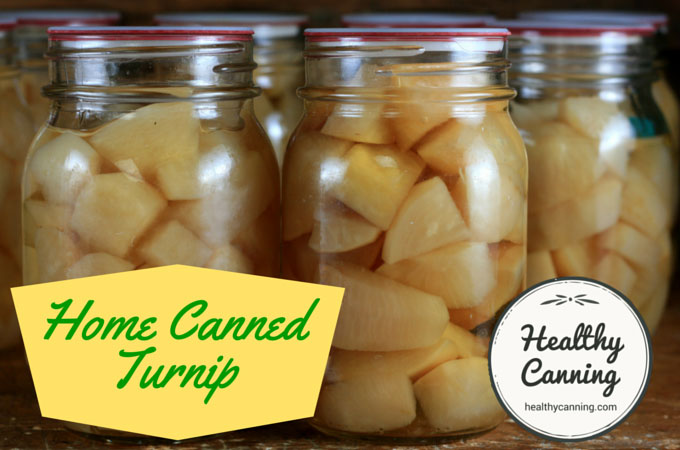
Turnip which came out light (unknown variety)
References

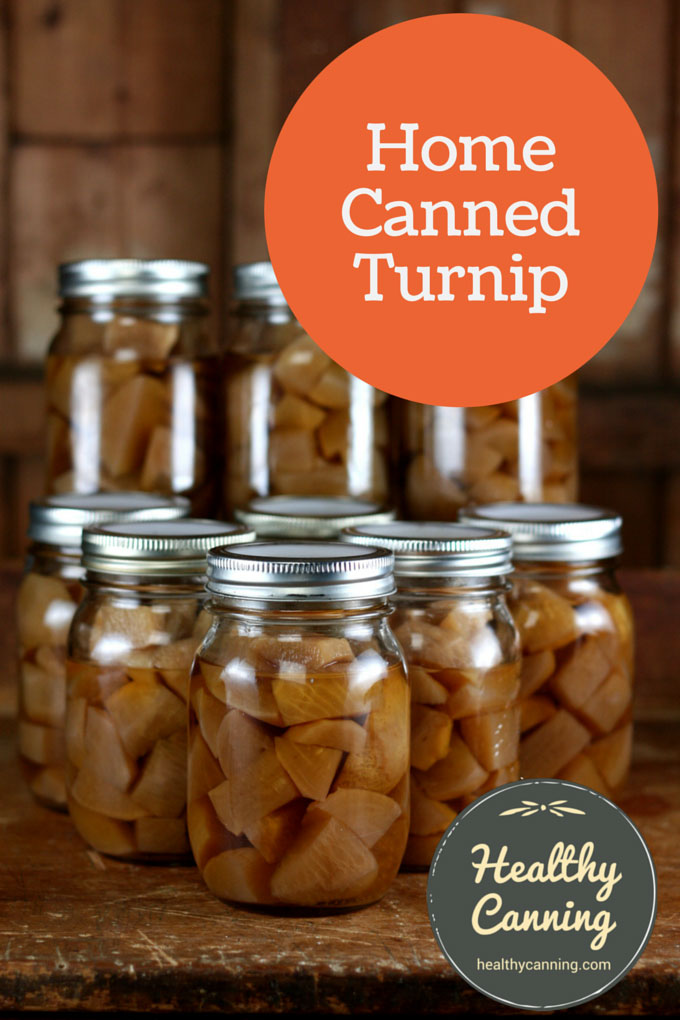
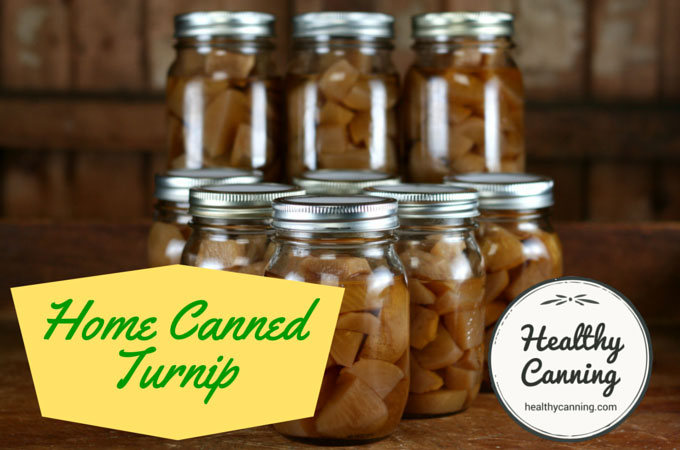
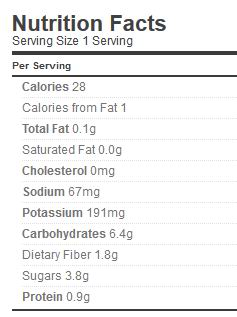
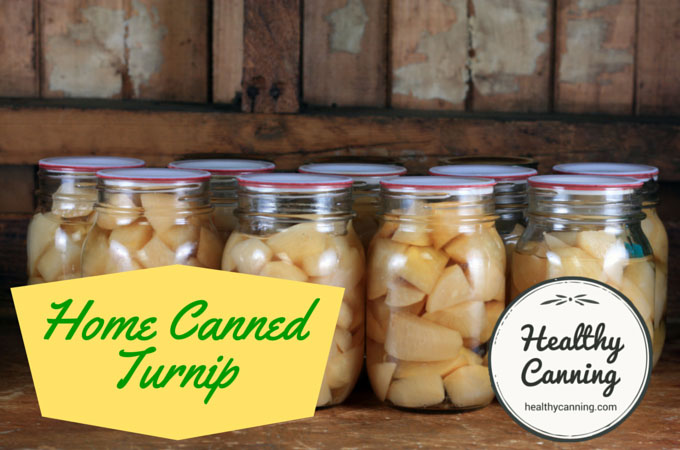
Jim Soehlman
Excellent source of information.
Noel
Would Hakurai turnips be suitable for canning or are they a variety that could turn brown?
Healthy Canning
We don’t have any experience with those to comment one way or the other, sorry.